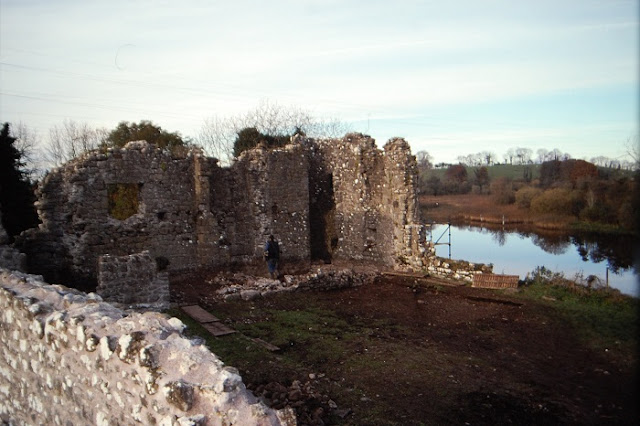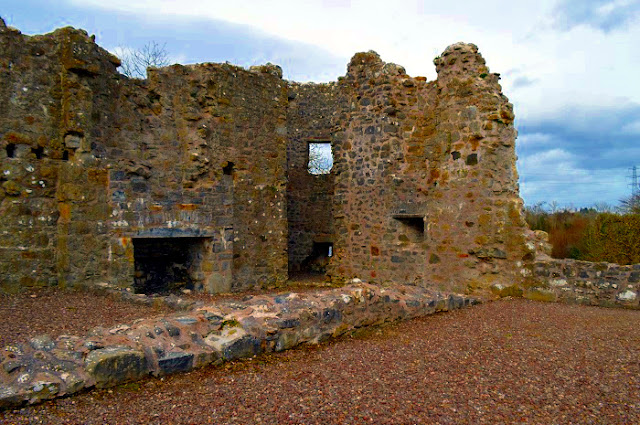Into the West: Portora Castle
So far on this trip
I’ve gone full prehistoric (Knockmany), followed it up with an excursion into
the Early Christian and Medieval (Errigal Keerogue), but now it was time for a
trip into the post-Medieval at Portora Castle. Essentially, I’ve been getting
younger as I’ve traveled west.
The castle is situated
on the banks of the Erne and once controlled access between Upper and Lower
Lough Erne. The standing structure was, essentially, four circular corner
towers, linked by curtain walling, with a three-story house (two floors with
attics) at the west end. Today, one of the corner towers is missing, having
been eaten away by the river and the house only survives as a foundation line.
The lands here were acquired by Sir William Coles in October 1612 and it is
thought that the castle was constructed soon after. At some time before 1621
the site was the residence of a Preacher called Mr Stack. The site was leased or
sold on to Bishop Spottiswood of Clogher who lived there from 1621 to 1628. During
Spottiswood’s tenure there (in 1622) a surveyor reported that there were two
timber-framed or ‘cagework’ houses within the bawn. The site was fortified and defended
for Governor
Henry Hamilton in 1688. After this it was the residence of the Cole family,
until the rather palatial Florence
Court was completed in the mid-18th century. It was probably abandoned at
that point and allowed to gradually decay. It suffered damage in 1858/9 when
schoolboys from nearby Portora Royal School
used explosives to blow up a substantial portion of the wall. Further damage
was done during the Night of the Big
Wind in 1893.
Portora is a lovely
little Plantation castle and well worth a quick visit. The views are grand, but
nothing spectacular. Don’t get me wrong – there are many fine views to be had
in Fermanagh … just not really on this spot, within the castle. So … why did I
divert my journey to see this site? Well, to me it’s a special place as during
November and December 1997 it was the scene of my first excavation in Northern
Ireland. I’d arrived in Belfast the previous September and had been working on
my MA thesis, but once cash reserves started to dwindle I needed something
approaching gainful employment. Turns out this was it! Before I arrived on
site, work around the house at the west end had uncovered the line of the front
wall, revealed parts of a ground-floor window, a door at the south end, and a
low-level pistol-loop. Inside the house, an unattached piece of walling was
interpreted as the base of a large fireplace. The fact that it was not linked
to other walls was taken to indicate that the internal walls were wooden.
Although there was very little evidence of 17th century activity in the house,
there were numerous finds of thin, unglazed earthenware tiles that indicated
that the house was tiled, rather than slated.
As I say, this was all
done before I arrived. I was put to work shovelling and trowelling in the open
courtyard or ‘bawn’. This is the area where the two ‘cagework’ houses were
supposed to have stood. I was exceptionally and irrationally excited to be
given my very own post-hole to excavate … not that it turned into very much,
but the excitement was real! Unfortunately, there was no evidence of the houses
or any other occupational deposits to be found. While the short description
published in the excavations bulletin suggests that the evidence had been
removed due to overzealous clearances during the 19th or early 20th century, it
had been speculated on site that the houses had never been built, and that the
report of them being there was more along the lines of ‘We’re planning to get
around to building these … honest!’. The summary doesn’t mention the feature we
initially thought was a well at the approximate centre of the bawn. It was
filled with water, but was blocked with a single large stone that would have
required specialised lifting equipment to move. Perhaps it was just considered
to be outside of the remit of the current excavations, but (if actually a well)
it could have had significant preservation of organic remains. Unfortunately, I
didn’t get to see the end of the excavation as I got a rotten chest infection
and was forced to quit until I could recuperate. Coming back to the site nearly
two decades later was rather wonderful and emotional – it gave me some
opportunity to think back honestly about my time in field archaeology. There’s
still much I’m proud of – some good sites shepherded from excavation to
publication – but so much I regret, too – not having been more active in
agitating for better pay and conditions, and supporting the setting up of a
Union when I had the chance. My advice to anyone still in the profession or
contemplating entering it is simple: join the Union and don’t accept poor pay
and conditions. Otherwise you too may end up – literally or metaphorically – watching
the river flow, wondering how it might have worked out had things gone a
slightly different way …
 |
| Site under excavation. December 1997 |
 | |
|
 | |
|
< 3D Images < Table of Contents
Notes:
If you go to the
Northern Ireland Sites and Monuments Record [here]
you can search for the site as FER 211:019. The scanned contents of the NIEA’s
SM7 file on the site is available [here
& here].
The entry in excavations.ie is [here].
Famous Portora Old Boys include Oscar Wilde, Samuel Beckett, Neill Hannon, and Nigel Dodds … which only
goes to prove that you can’t have everything …













Comments
Post a Comment